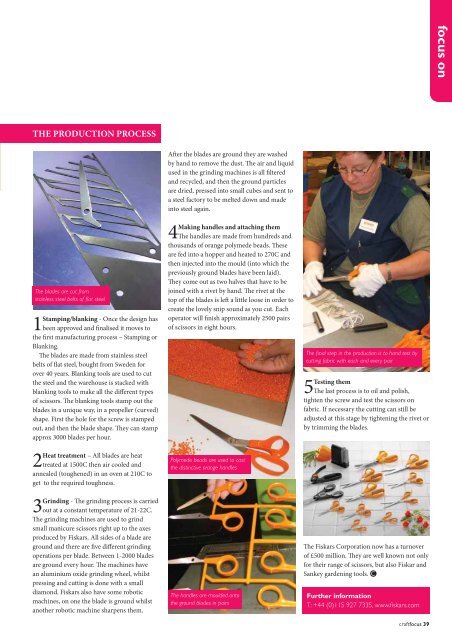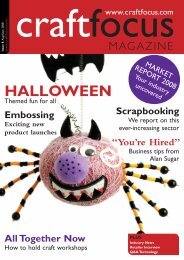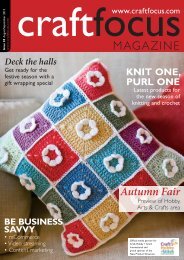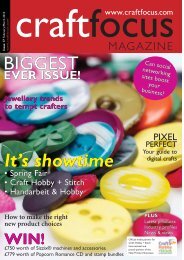business advice - Craft Focus Magazine
business advice - Craft Focus Magazine
business advice - Craft Focus Magazine
Create successful ePaper yourself
Turn your PDF publications into a flip-book with our unique Google optimized e-Paper software.
focus on<br />
THE PRODUCTION PROCESS<br />
The blades are cut from<br />
stainless steel belts of flat steel<br />
Stamping/blanking - Once the design has<br />
1 been approved and finalised it moves to<br />
the first manufacturing process – Stamping or<br />
Blanking.<br />
The blades are made from stainless steel<br />
belts of flat steel, bought from Sweden for<br />
over 40 years. Blanking tools are used to cut<br />
the steel and the warehouse is stacked with<br />
blanking tools to make all the different types<br />
of scissors. The blanking tools stamp out the<br />
blades in a unique way, in a propeller (curved)<br />
shape. First the hole for the screw is stamped<br />
out, and then the blade shape. They can stamp<br />
approx 3000 blades per hour.<br />
Heat treatment – All blades are heat<br />
2 treated at 1500C then air cooled and<br />
annealed (toughened) in an oven at 210C to<br />
get to the required toughness.<br />
Grinding - The grinding process is carried<br />
3 out at a constant temperature of 21-22C.<br />
The grinding machines are used to grind<br />
small manicure scissors right up to the axes<br />
produced by Fiskars. All sides of a blade are<br />
ground and there are five different grinding<br />
operations per blade. Between 1-2000 blades<br />
are ground every hour. The machines have<br />
an aluminium oxide grinding wheel, whilst<br />
pressing and cutting is done with a small<br />
diamond. Fiskars also have some robotic<br />
machines, on one the blade is ground whilst<br />
another robotic machine sharpens them.<br />
After the blades are ground they are washed<br />
by hand to remove the dust. The air and liquid<br />
used in the grinding machines is all filtered<br />
and recycled, and then the ground particles<br />
are dried, pressed into small cubes and sent to<br />
a steel factory to be melted down and made<br />
into steel again.<br />
Making handles and attaching them<br />
4 The handles are made from hundreds and<br />
thousands of orange polymede beads. These<br />
are fed into a hopper and heated to 270C and<br />
then injected into the mould (into which the<br />
previously ground blades have been laid).<br />
They come out as two halves that have to be<br />
joined with a rivet by hand. The rivet at the<br />
top of the blades is left a little loose in order to<br />
create the lovely snip sound as you cut. Each<br />
operator will finish approximately 2500 pairs<br />
of scissors in eight hours.<br />
Polymede beads are used to cast<br />
the distinctive orange handles<br />
The handles are moulded onto<br />
the ground blades in pairs<br />
The final step in the production is to hand test by<br />
cutting fabric with each and every pair<br />
5Testing them<br />
The last process is to oil and polish,<br />
tighten the screw and test the scissors on<br />
fabric. If necessary the cutting can still be<br />
adjusted at this stage by tightening the rivet or<br />
by trimming the blades.<br />
The Fiskars Corporation now has a turnover<br />
of £500 million. They are well known not only<br />
for their range of scissors, but also Fiskar and<br />
Sankey gardening tools. C<br />
Further information<br />
T: +44 (0)115 927 7335, www.fiskars.com<br />
craftfocus 39
















